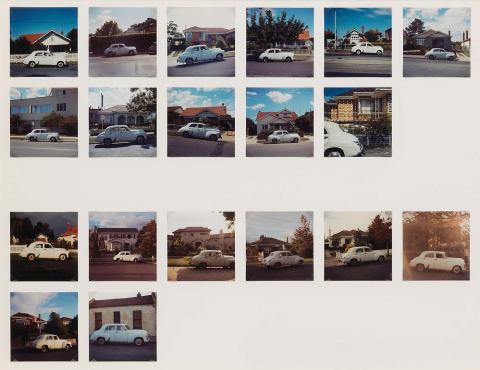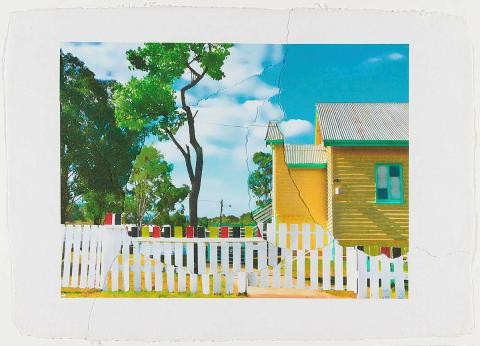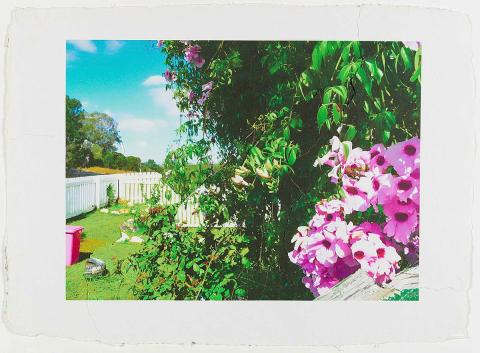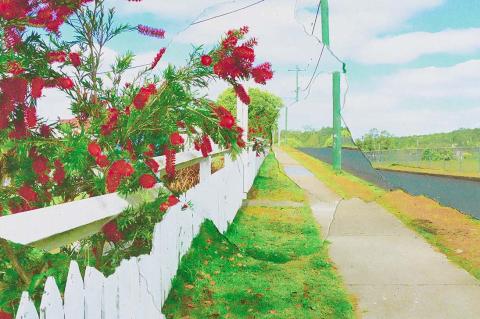Images from everyday life
By Grace Jeremy
Artlines | 2-2024 | June 2024
| Editor: Stephanie Kennard
The new Collection exhibition ‘Suburban Sublime: Australian Photography’ explores how artists have used the medium to interpret the Australian suburbs. The exhibition brings together works that pause to reflect on everyday settings, places, and people, imbuing them with aesthetic, historical and emotional significance, writes curator Grace Jeremy.

While rationales for capturing ‘suburbia’ vary, the artworks in ‘Suburban Sublime: Australian Photography’ consistently demonstrate the enduring role of photography in enriching the national understanding of familiar scenes and images from everyday life.
Often recognised for embodying the concept of ‘suburban sublime’ in his practice, Bill Henson is one of the most celebrated photographers working today. In the mid-1980s series ‘Untitled 1985/86’, he treats the service stations, restaurants and people of suburbia with a sensitivity that is normally reserved for places of worship, or historically significant architecture. Many of the photographs appear to be taken at dusk, with Henson drawing on his command of colour and light to create monumental images that are influenced by Baroque sensibilities. Reflecting on the series, Henson has said:
I realised that it wasn’t the landscapes I was interested in but the dreamscapes: the way people carry their past and their childhood around inside of them . . . Suddenly I could look at it as an imaginary landscape rather than a realistic one.1
Despite the familiarity of his content, Henson’s calculated framing allows the emotion and subjectivity of a scene to supersede any sense of location and context. Often favouring such ambiguities, he imbues his images with a universal and timeless quality.

Untitled 1985-86
- HENSON, Bill - Creator

Untitled #28 1985-86
- HENSON, Bill - Creator

Untitled #73 1985-86
- HENSON, Bill - Creator
In contrast to Henson’s drama, Robert Rooney depicts the suburbs in a mechanical, serialised manner. He documented Melbourne’s suburbs in 1970 with his first major photographic artwork War Savings Streets, which contained a poster displaying a grid of 60 photographs mapping the streets involved in donations programs during World War Two. His approach was influenced by North American artist Ed Ruscha, who Rooney has described as treating his camera like a ‘technical recorder’.2 While shooting War Savings Streets, Rooney noticed the continual presence of the vehicle he was using, a Holden FJ belonging to his friend, musician Barry McKimm, in the photographs. He subsequently created Holden Park 1, March 1970 & Holden Park 2, May 1970 1970, showing McKimm’s car parked in various streets, with the locations chosen through a pre-determined system of placing a transparent sheet with dots over a street directory.3 Photography as a medium lends itself to repetition; Rooney’s ritualised process foregrounded its importance to the development of conceptual art.

War Savings Streets 1970
- ROONEY, Robert - Creator

Vale Street 1975
- JERREMS, Carol - Creator
Photography thrived in Australia in the 1970s, with the decade seeing increased institutional support for the medium and artists using it to document the socio-politics of the era. Melbourne photographer Carol Jerrems worked among the anti-establishment counterculture of the day, with her practice geared towards feminism and optimistic social change. Her most famous photograph, Vale Street 1975, is a portrait of then aspiring actor Catriona Brown and two of Jerrems’s former students, teenagers Mark Lean and Jon Bourke. Standing in a St Kilda backyard, Brown assuredly occupies the foreground, flanked by Lean and Bourke, who eerily hover behind her. In 1999, Brown explained how Jerrems framed the image: ‘[Jerrems] chose the boys being angry, cunning and watching carefully, guarding themselves against my openness, directness and honesty . . . She was a great observer of people’.4 Enduringly compelling, Vale Street has become a defining image of the 1970s.

Tracey Moffatt’s 2013 ‘Picturesque Cherbourg’ series uses landscape imagery to address highly personal human experiences. On first glance, nothing seems out of the ordinary in these bright snapshots of suburban Queensland streets. However, a closer viewing reveals deep tear lines through the photographs — which, even after being pasted back together, remain fractured, even ruptured. The town of Cherbourg was established as a mission in 1901 and later became a government settlement, where many Indigenous peoples were sent to live after being forcibly removed from Country. Describing the trauma of her family members who lived at the Cherbourg settlement, Moffatt has said, ‘The old people don’t want to talk about it, like war veterans’.5 Kathryn Weir, a former curatorial manager at QAGOMA, noted that Moffatt’s use of ‘sun-saturated colour’ conveys Cherbourg’s ‘complex fabric of pain and getting-on-with-it resilience’.6 Contextualising these picture-perfect images with violent tears, Moffatt reminds us of the psychological burden of historical realities that are often hidden behind seemingly pleasant exteriors.
The photographs in ‘Suburban Sublime’ demonstrate the artistic potential of familiar places and moments that might otherwise be overlooked in the rhythms of daily life. Across two rotations, the exhibition features work by artists including William Yang, Pat Brassington, Richard Stringer, Ruth Maddison, Glen O’Malley, Naomi Hobson, Lindy Lee and more. Despite their varied origins and subjects, the works on display encourage us to look more closely at the everyday and the places we inhabit.
Grace Jeremy is Assistant Curator, Australian Art, QAGOMA. This essay was originally published in Artlines 2-2024.
‘Suburban Sublime: Australian Photography’ is on display in Gallery 6 of the Henry and Amanda Bartlett Galleries at QAG, from 10 August 2024.
- Bill Henson in conversation with Tempe Nakiska, ‘Bill Henson’s suburbia: The iconic photographer reflects on dusk dreamscapes and the worlds we create’, Hero Magazine, 20 November 2014, viewed March 2024.
- Robert Rooney quoted in Robert Lindsay, ‘Robert Rooney’, Art and Australia, vol.14, no.1, 1976, p.56.
- Jenepher Duncan, ‘Robert Rooney: Biography’, in From the Homefront: Robert Rooney, Works 1953–1988 [exhibition catalogue], Monash University Gallery, Melbourne, 1990, p.39; and Lindsay, p.56.
- Catriona Brown quoted in Natalie King (ed.), Up Close: Carol Jerrems with Larry Clark, Nan Goldin and William Yang [exhibition catalogue], Heide Museum of Modern Art, Melbourne, 2010, p.47.
- Tracey Moffatt quoted in Kathryn Weir, ‘Tracey Moffatt: Home and away’, in Tracey Moffatt: Spirited [exhibition catalogue], Queensland Art Gallery, Brisbane, 2014, p.26.
- Weir, p.26.

‘Suburban Sublime’
Aug 2024 - Aug 2025

Digital Story Introduction
SUBURBAN SUBLIME‘Suburban Sublime: Australian Photography’
Read DIDACTICDigital story context and navigation
SUBURBAN SUBLIMEExplore the story

‘Suburban Sublime’
Aug 2024 - Aug 2025





